I get survey requests from the AAO regularly and I like to take them to see what residents, and thus their faculty, think is important. It also gives insight into what the people handing out grants are interested in since the students and faculty try to create studies to impress them. Usually it’s something totally worthless like cephalometric analysis or someone trying to prove that their orthodontic technique doesn’t require retention but every once and a great while something interesting arrives. Today was like that.
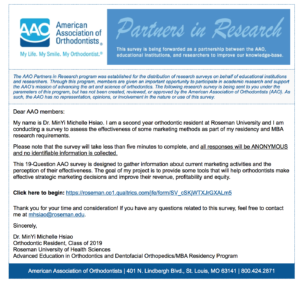
I took the survey (I tried to link to it here to get this resident more responses but it wouldn’t let me) and found some very interesting questions were asked. See for yourself (with my comments):

The assumption here is plain. A million dollar practice is a big practice and the median practice is probably in the 750 k range with a ton of young orthodontists collecting less. The average numbers put out by the AAO and JCO are more like 1.2 million but they are not in alignment with the median numbers which are much lower I’m willing to bet. The perception of this resident and the faculty make this plain. The truth is that collecting a million dollars in an orthodontic practice is not much – go visit a few people who are actually doing 2 or 3 or 4 or 5 or more a year and you’ll see what I mean. As I’ve said many, many times, an owner operator with 7-8 chairs, a single office and a fee in the $5000 range can do great work and produce $1.5 million a year per day a week they work. The Relentless Pursuit of Mediocrity and the defense of what we have always done to justify our poor results in orthodontics needs to stop.
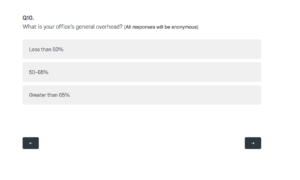
Overhead is creeping up – no it’s surging. Industry experts say that 60+ percent overhead is normal for most practices. This has a lot to do with struggling practices investing in technology to “increase their capacity and speed” when they are not at capacity and don’t need to go faster but it also has to do with the difficulties of stopping at a million dollars in production. A million dollars in collections is eaten up very quickly in the modern landscape so it’s tough to be very profitable at even what the AAO considers an average size practice. And of course you have to pay student loans! If you increase the size of your practice and stay in the owner/operator model then your overhead will fall dramatically. If you add offices and associates this is not the case – overhead will skyrocket.
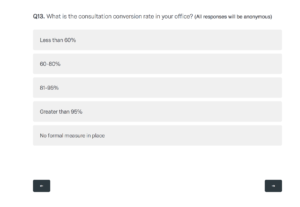
Conversion rate is still the end all, be all of orthodontic metrics if you listen to the crowd on Facebook, the orthodontic experts and pretty much anyone else. Nothing could be further from the truth however. The only things that matter are how may starts you do a month and how much it costs you to get and accommodate said starts. PERIOD. I can’t tell you how many instances I’ve seen where orthodontists retain a professional marketer and embark on DTC marketing campaigns, get tons of leads, start more cases, make more money… but still complain that their conversion rate has decreased. WHY THE HELL DOES IT MATTER IF YOUR CONVERSION RATE GOES DOWN IF YOU START MORE CASES? If you want to access the huge, untapped patient pool out there then you’ll have to give up this silly notion that conversion rate is a grade you get and it matters. I’m afraid it will take a long, long time before this is accepted in orthodontics given our career student status.
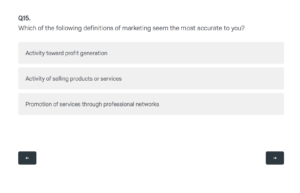
What? I don’t even understand what this means. I assume they are trying to make the case that anything other than getting patients through professional networks is bad? Marketing is selling you, your brand, your team, your building, your services, your reputation, your price, your financing… everything. Marketing happens every single time you or your people or your brand interfaces with the public or other dental professionals.
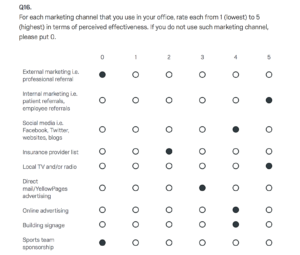
I love this question and the next one the most. Between the two the clear implication is that there are classifications of patients and that just because one marketing channel produces leads it may not produce “quality leads” and thus can upset your precious conversion rate. Silly. Wasteful. Destructive. But believed by 98 percent of orthodontists. I wonder how long we will hold onto this stupid notion just because we always have?
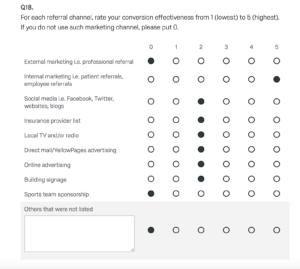
See above comment.
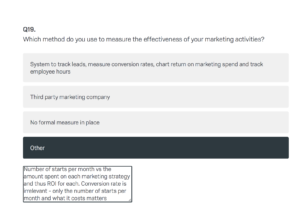
Tracking your results is critical. But the only thing that matters is the number of contracts you sign a day/week/month/year and how much it costs you to acquire them, service them and get them the result they desire. Conversion rate is useless…
Words have meanings. Perception is everything. If we look closely and think instead of assume it’s easy to see why orthodontics and orthodontists are struggling in the new reality. Our struggles are of our own making and that’s good news because if we had the power to get ourselves into this mess, we have the power to change and get ourselves back on track. Unfortunately most orthodontists and organized orthodontics would rather claim the moral high ground while defining ourselves as victims of outside forces beyond our control. When we do this we surrender our power to control our own destiny. Don’t be that orthodontists. Figure out what patients want, what they are willing to pay and how they are willing to receive your services and give it to them! It’s that simple. To do otherwise in any business is folly!

